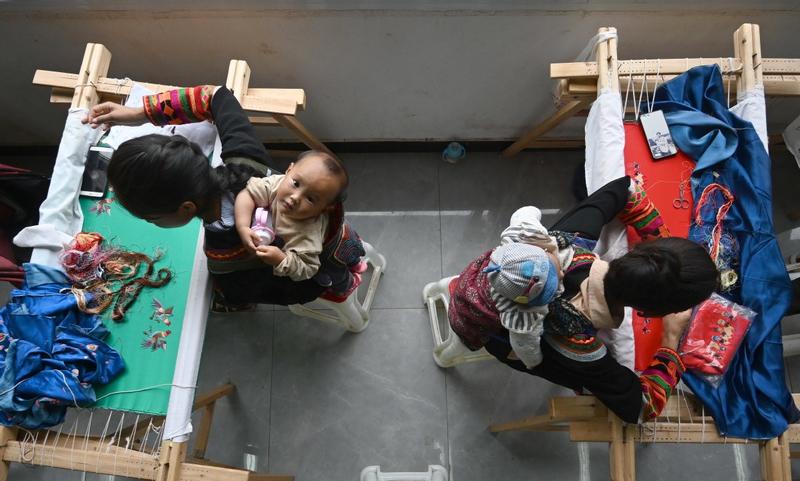 Women embroider with babies on their backs at a workshop in Meigu county of Liangshan Yi autonomous prefecture, Sichuan province, on Aug 31, 2020. Authorities introduced embroidery businesses from Foshan, Guangdong province to help local women find employment close to home. ( HUA XIAOFENG / CHINA DAILY)
Women embroider with babies on their backs at a workshop in Meigu county of Liangshan Yi autonomous prefecture, Sichuan province, on Aug 31, 2020. Authorities introduced embroidery businesses from Foshan, Guangdong province to help local women find employment close to home. ( HUA XIAOFENG / CHINA DAILY)
China's antipoverty drive has made headway in empowering poor, rural women with assistance ranging from easy loans to health checks, said an official with the All-China Women's Federation, as official figures have spotlighted female susceptibility to extreme poverty.
Zhang Dongmei, a member of the federation's secretariat, said of the 93 million Chinese who have escaped absolute poverty since late 2012, about half are women.
Keeping girls in school has a huge positive impact on economic development because they have a high chance of getting a proper job and becoming productive in society.
Leslie Maasdorp, vice-president and chief financial officer at New Development Bank
Female poverty is a major target of the nationwide poverty reduction efforts, and women are a major force in taming rural impoverishment, she said.
The central authorities have rolled out a host of tailored measures to curb female poverty, including a 2015 resolution to offer rural women free health checks aimed at early detection of cervical and breast cancer, she added.
Cancer and other serious illnesses can lead to expensive medical bills and bankrupt less affluent families.
Figures offered by the federation showed women accounted for 45 percent of the rural poor, and 40 percent of them were impoverished because of crippling medical bills.
ALSO READ: More female migrant workers return to aid children
The federation said they have teamed up with the National Health Commission and rolled out 100 million tests for cervical cancer and 30 million tests for breast cancer.
A total of 160,000 women with the cancers have received financial aid.
The 2015 resolution also required stepped up efforts to hand out small loans to help rural women start family businesses and improve care services for left-behind children and women with limited incomes.
Zhang said the federation has moved to lead women to set up more than 300,000 homestays and rural cooperatives over the past five years and trained large numbers of female experts in e-commerce, rural tourism and domestic services, among other industries.
ALSO READ: County cooks up noodles to fight poverty
The poverty relief drive has boosted women's economic standing, and more importantly has led to changes in their "thoughts, spiritual outlook, lifestyles and health conditions", she noted.
According to the All-China Women's Federation, the female impoverishment rate was 0.4 percentage points higher than their male counterparts in 2010. The gap has gradually closed over the years and had nearly vanished by 2019.
To end the poverty cycle, the federation also worked to bolster school turnout among girls, who are susceptible to dropping out when family finances are strained.
The Spring Bud Project, which was launched by a foundation overseen by the federation, said they have raised 200 million yuan (US$29.4 million) in charitable funds and helped 200,000 schoolgirls from financially strapped families.
"Keeping girls in school has a huge positive impact on economic development because they have a high chance of getting a proper job and becoming productive in society," said Leslie Maasdorp, vice-president and chief financial officer at New Development Bank, a multilateral bank established by the BRICS countries-Brazil, Russia, India, China and South Africa.
READ MORE: Tea project discovers a fresh blend to end poverty
It has been proven throughout the world that investment in women and girls has a much bigger economic developmental impact, he said.
He noted that if women are provided with loans or other business opportunities, they are more likely to pay them back, as is evidenced by the experiment.


